Talk about serendipity. I had been in contact with journalist, artist, and animal activist Twig Mowatt for quite a while. When I visited her pet portraits site, I was not only impressed by her art but also struck by the section about how to take a photograph that could be used as a basis for her portraits. Because my photographs, well, suck, and I’m intimidated by the technical nature of much professional advice, I asked her if she would expand on that information with a guest post, which she sent in last week.
And here’s the convergence: How propitious is it that I’m also running a contest with DogJaunt.com that requires photos to be submitted? Now you have no excuse not to enter — well, okay, no excuse that involves the ability to take good pet photos (which you weren’t really going to be judged on anyway, so I admit I’m on shaky ground, but I needed to provide a reason for people to link to the contest).
Without further ado…
***
As a pet portrait artist, I started out determined to work from sketches of live models. That effort lasted about 45 seconds—which is the amount of time that it took my dog to go from adorable couch potato to rigidly attentive squirrel sentry. From then on, I knew I had to work from photos.
But getting a good—even workable—photo is tricky. Every detail is critical in capturing the spirit of an animal: the subtle color variations of a black lab, the clear outline of a crooked whisker, and every aspect of the eyes. The rest of the body can be perfectly photographed, but if the eyes aren’t clear, then the portrait is never going to do justice to the model.
I am not a photographer and I use a cheap camera that is duct-taped closed, but I have still found a few things that help in getting a good photo. I’m including some examples of classic mistakes here, as well as some photos that are imminently workable, if not entirely perfect.
A close-up of the animal’s face is key. Get in close and get on your pet’s eye level. Don’t shoot down, don’t shoot up. Fill up your viewfinder with the face. Lucie, below, is a good example of shooting at eye level and filling the viewfinder.
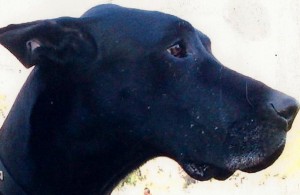
Natural lighting is best, whether inside or out. A flash may distort overall color, making black labs look jaundiced; see Yellow black Lab.
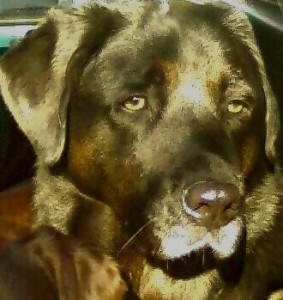
It may also bring on the dreaded “pet eye,” which is like “red eye” for people, only in more colors. See Ella for an example of green and yellow pet eye.
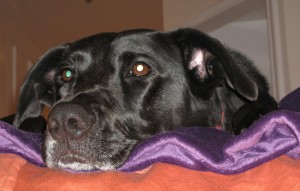
Tools that correct red eye don’t work on multi colors, but you can photoshop your way to a reasonable result with the help of websites such as http://graphicssoft.about.com/od/redeyeremoval/ss/peteye.htm. These help you to black over the offending part and then go back in to introduce the all-important glint. However, the end result may suggest that your pet has been hypnotized, so it’s still best to avoid pet eye altogether. If natural light alone isn’t working, try having your pet not looking directly into the lens. See Mullett for a good example—even though there is still a little too much reflection—of capturing eye detail. Plus, you can see every individual whisker!
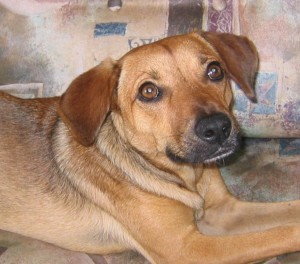
Take lot of shots and take them in a setting where your animal is comfortable and happy. Though I treasure the horrified look on the face of my border collie mix after I shot him draped in Christmas decorations, it wouldn’t make for a good portrait.
Try to avoid shooting a dark dog against a dark background and a light-colored dog against a light one. Even if the portrait artist opts for an entirely different background, such as a solid color, the overall lack of differentiation makes it much harder to see the color nuances that make your pet unique. White on White is a good example of this.
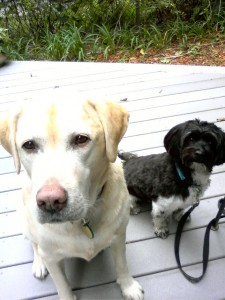
Think about colors and textures that will best show off your pet. See Buddy for a great example of good color, texture, composition—but the eyes, alas, are black holes.
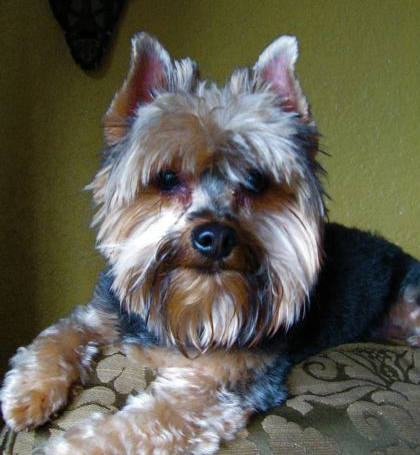
See Cutie 2 for another terrific composition, with good color and texture. This photo was by renowned dog photographer Heather Bohm-Tallman.
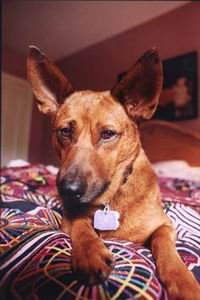
Think about the composition. If there are paws showing, do they look connected to your subject or do they seem to pop up out of nowhere? Look again at Ella, above, for an example of paws that don’t actually seem connected to her body… By the way, I LOVE Ella, so I hate to pick on her photo.
Profiles are a great way to convey nobility. Just be sure it is a full profile and that no part of the far eye—not even an eyelash—is showing. The photo of Lucie, above, is a good example of how a profile can convey character. The shot isn’t technically very good, but you can just feel Lucie’s depth and wisdom.
Twig Mowatt is a free-lance journalist and pet portrait artist, whose work helps support various animal welfare causes including international spay and neuter efforts, Puerto Rican dog rescue, and ending greyhound racing.
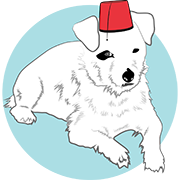
Some great information! I would love to remove the “green eye” from this: http://bit.ly/c1luHN I think it really captures Caffeine’s goofball personality.
Great picture! Your mission, should you chose to accept it: Try the correction program and send in the “after” picture.
Thanks for the useful post! I’m always interested in learning how to take better dog pics.
Many times, our pet travel pics don’t include closeups of Ty and Buster as we are trying to capture the overall feel of a pet friendly location. But every now and then, a close up shot is desirable (if only to ad to our personal album). These tips will be extremely helpful for those photos!
What a remarkable handbook in such a user friendly format! The illustrations help so very much (but I didn’t see a single dog who wasn’t cute, I have to admit). Emboldened by this primer, I may dust off the camera and catch a few shots of Archie…and I am a confirmed technophobe.
Hey, great post! It seems inevitable that dogs just move when I’m taking the picture, so part of the ear is cut off, or some of the face is out of the frame, or, my fave, we’ve got blur! But it is so true that you must shoot from eye level with the dog. I learned that when going through photos that would capture peoples’ hearts for the shelter website. Now dog wrangling is no easy feat, but face shots are the thing–as Twig mentioned, it’s about the eyes. Also good to have another program to get rid of incorrect eye color. Thanks!
Hey, these are some really good tips – I especially like the ‘shoot at dog level’ and ‘natural light’ pointers and to pay attention to the background and the issue about ‘pet-eye’- no matter how long you’ve been doing this, these are great suggestions to bear in mind. and, Edie, I did get some (well reasonablygood) good shots of Frankie when we visited Tucson back on Valentine’s Day, and this is just the ‘noodge’ to get me to resize and send them to you! -he is one tough cookie to get a good shot of- all the more rewarding when he finally gives you the ‘look’ – hey did you teach him that ,or whhatt?!!
That means a lot, coming from a professional photographer, Diane!
I will welcome the shots of Frankie (even though he is a bad, bad dog — he just lifted his leg and peed on the living room rug, blatantly, without any requests to leave the house…but that’s another blog). That’s relevant because apparently I can’t teach him anything — and especially not the look.
But it’s the two of us together that seems to elude photographers. How good are you at photoshop? I’m not above an honest composite — although if you want to make me look younger, I’m not above a dishonest composite either. Frankie of course should remain unretouched.
great tips! I’ve never really been able to take any nice portraits of my dogs. they can’t stop moving or they would just turn their heads away when i’m shooting, i suspect they are camera-shy.
Thanks for your comment — for some reason my spam filter ate it, so I didn’t get to approve it until today.
Really helpful info and someone who wants to end greyhound racing too. Twig, you’re an angel in my book. I’m going to FB this post.
Edie: Thanks for another stellar post. Photographing my little brown Muffin has become a true (and very enjoyable) obsession! I got my first serious digital camera after adopting her in 2006 and have since taken over 10,000 photos of her–something I never could have done in the film days! Recently a photo of her adorned a full page in a published doggie book, but the overwhelmingly majority are disappointments that hardly capture her true spirit, depth, and cuteness or they’re just dark, blurry, or whatever. She definitely doesn’t try to cooperate either, and her dark complexion creates further challenges. My only additional tip would be to photograph your dog as YOU see her. Getting down to her level is great–I try to do it all the time–but if your pov also includes standing above her as stares up at you so lovingly, try capturing that too.
I’m just the conduit here, channeling Twig Mowatt, but I’m glad you enjoyed the post. Thanks too for your tip about the position of the camera; the adoring look up is definitely worth capturing.